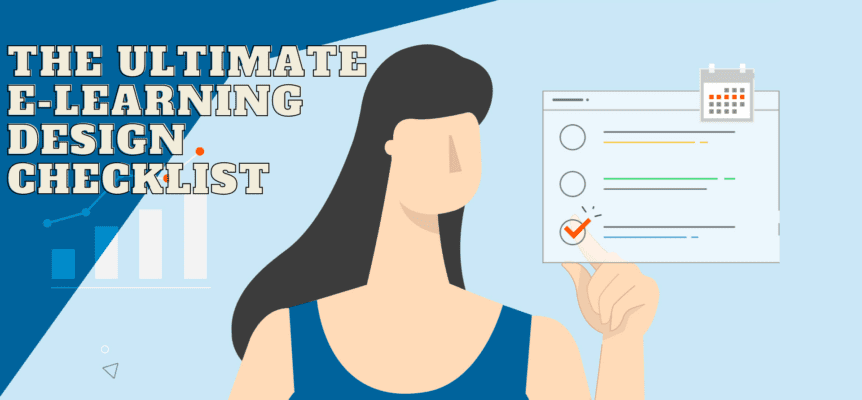The Ultimate E-Learning Design Checklist
E-learning design projects have a lot of moving parts and can involve a number of people. It is important to take a structured approach to ensure everything is successfully completed and nothing is missed. This e-learning design checklist will help you create effective, engaging, and impactful learning experiences.
There are some points on the checklist that are not relevant in all situations, and an element of customisation might be needed to adapt the checklist to your requirements. That said, this e-learning design checklist provides you with a comprehensive quality control tool to ensure your e-learning course is as good as possible.
1. Learning Objectives
- A training needs analysis has been conducted to ensure there is a comprehensive understanding of the current capabilities of learners.
- The learning objectives are clearly defined and outline what the learner will know or be able to do after completing the course.
- The learning objectives are measurable.
- The learning objectives are aligned with the content and assessments in the e-learning course.
2. Working with Your E-Learning Development Partner
- The project has been fully scoped and the expectations you have for the course have been clearly defined.
- Milestones have been agreed as well as the final deadline.
- Responsibilities have been agreed in full, including who is responsible for producing the various content elements.
- The process for assessing progress and signing off the various stages has been agreed.
3. Content Development
- The content is accurate, up-to-date, and relevant to the needs of learners.
- The information is chunked into manageable segments or modules.
- The information is presented in a logical order that facilitates learning.
- There is a balance of media elements, including text, images, charts, graphics, and videos.
- There are interactive elements that will engage learners such as quizzes, scenarios, drag-and-drop activities, etc.
- There is no unnecessary content to avoid information overload.
- The content has been checked for spelling and grammatical errors, including text on images, charts, and videos.
- Supplemental resources have been provided for learners who want to explore the topic further.
4. Visual Design
- The design of the e-learning course is aligned with your brand.
- The fonts, colours, and styles are all consistent.
- All text is easy to read.
- The graphics, videos, and other media elements are meaningful, relevant, and high-quality.
- There is sufficient whitespace to reduce cognitive load.
- The e-learning course has a responsive design to ensure it works on all devices, including phones.
5. Interactivity and Engagement
- There are opportunities for learners to practice skills or apply knowledge.
- Meaningful feedback is provided when learners take an action, answer a question, or make a decision.
6. Assessments and Feedback
- The assessments align with learning objectives.
- There are assessments included during the course and at the end.
- Multiple forms of assessment are included.
- In quizzes, there is variation in the types of questions that are asked.
- Instant feedback is provided on quizzes and other assessments with learners given the opportunity to learn from mistakes and make corrections.
7. Navigation and Usability
- The navigation is intuitive and easy to use.
- A progress tracker or status bar has been included.
- There are options to bookmark or save progress.
- The navigation allows learners to move forward and backward throughout the course.
- All multimedia elements, including videos, animations, and audio, have play, pause, and stop controls, as well as volume controls.
- Accessibility features have been included, such as captions, alt text for images, and keyboard-friendly navigation.
8. Social and Collaborative Learning
- Where applicable, opportunities for discussion have been provided, including peer-to-peer discussion or discussions with a trainer.
- Group projects or collaborative activities have been included.
- The e-learning course has been integrated with social media channels.
- Any in-person or in-classroom sessions have been seamlessly blended with the e-learning elements.
9. Motivation and Encouragement
- Gamification elements have been included to boost learner motivation, such as badges, certificates, or points.
- The learner experience includes positive reinforcement at all stages of the course.
- Expectations are clearly stated at the start of the course.
10. Technical Considerations and Quality Control
- The e-learning course has been tested to ensure it loads correctly on all intended devices and browsers.
- All file sizes are optimised/minimised to ensure fast loading/downloading.
- All links, buttons, and interactive elements have been tested to ensure they function correctly.
- The integration with your Learning Management System (LMS) has been tested.
11. Testing and Feedback
- The e-learning course has been pilot-tested with a small group of learners.
- Feedback has been received on the effectiveness and engagement of the course, as well as any technical glitches.
- Updates and improvements have been implemented based on the feedback.
Using the E-Learning Design Checklist to Optimise Course Development
The best approach when working through an e-learning course development project is to refer to this checklist regularly. This will ensure you have a clear understanding of what has been completed and the stages that are still in progress. It might look like a long list at first glance (there are around 50 points on the list), but it will ensure consistent high-quality design.
